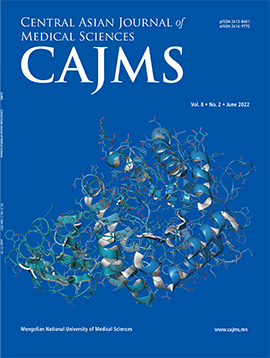The Helicobacter Pylori Genotyping Among Mongolian Dyspeptic Patients
DOI:
https://doi.org/10.24079/cajms.2022.06.005Keywords:
Atrophy, Bacteria, Immunohistochemistry, Histology, Reflux, Gastritis, SequenceAbstract
Objective: The prevalence of H. pylori infection varies significantly and developing countries are found to be the highest in Asia. In the present study, we have aimed to perform a combined analysis of histochemical stains and IHC to confirm the H.pylori infection of patients in 5 different provinces and Ulaanbaatar city, Mongolia. Method: Five hundred and thirty-eight patients were enrolled in this study (142 gastric mucosal atrophy, 333 gastritis and 62 gastroesophageal reflux). Results: 67.1 % of participants had CagA positive and 69.3 % were immunohistochemically positive. All histological results showed that the gastritis group was significantly higher in patients who were positive for H. pylori than in antral-predominant gastritis. By the hematoxylin and eosin staining with May– Giemsa confirmation by IHC, the prevalence of H. pylori infection in the gastric mucosal atrophy group was 62.1 %, while in the gastritis and gastroesophageal reflux group, the rate was 74.3 % and 59.1 %, respectively. Conclusion: CagA sequence profile in each group of patients revealed that 22.6 % of the gastric mucosal atrophy group was ABC type, 43.4 % was ABCC type and 33.9 % was ABTC type. On the other hand, in the gastritis group, the dominant type was ABTC (41.3 %). In the gastroesophageal reflux group, the ABCC type was dominant while 23.1% was the ABC type.
Downloads
333
Downloads
Published
How to Cite
Issue
Section
License
Copyright (c) 2022 Mongolian National University of Medical Sciences

This work is licensed under a Creative Commons Attribution-NonCommercial 4.0 International License.




